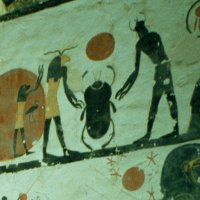New tomb belongs to members of 18th Dynasty pharoah's court
Members of an 18th Dynasty pharaoh's court are likely buried in the first new tomb uncovered in Egypt's Valley of the Kings in more than 80 years, one of the archaeologists involved in the find said Friday.

So far, archaeologists have not entered the tomb, having only opened part of its 1.5-meter (yard)-high entrance door last week. But they have peered inside and have seen that that the single-chamber tomb contains five wooden sarcophagi, believed to contain mummies, surrounded by around 20 pharaonic jars.
American archaeologists discovered the entrance to the tomb by accident while working on a neighboring tomb, Edwin Brock, co-director of the University of Memphis team, told The Associated Press.
"It was a wonderful thing. It was just so amazing to find an intact tomb here after all the work that's been done before. This was totally unexpected," Brock said.
The new tomb did not appear to be that of a pharaoh, he said. "I don't think it's a royal tomb, maybe members of the court."
"Contemporaries of Tutankahmun are possible, or of Amunhotep III or even Horemheb," he said. Based on their style, the jars appear to date to the late 18th Dynasty.
On Friday, Egyptian antiquities authorities allowed journalists a first look into the tomb through the opening in the door, located at the bottom of a 10-meter (yard) shaft. It is located near the tomb of Tutankhamun, the last new burial site to be discovered in the valley, in 1922 by British archaeologist Howard Carter.
The discovery has broken the long-held belief that there's nothing left to dig up in the Valley of the Kings, the desert valley near the southern city of Luxor used as a burial ground for pharoahs, queens and nobles in the 1500 BC-1000 BC New Kingdom.
The 18th Dynasty lasted from around 1500-1300 BC and included the famed King Tut. Photos released by the Supreme Council of Antiquities showed the interior of the tomb, the bare stone walls undecorated, with at least five sarcophagi of blackened wood amid white jars, some apparently broken.
The coffins appear to have some damage from termites, Brock said. "Its going to take a lot of conservation work to consolidate these things before we can take them out," he said of the sarcophagi.
I.L.
Subscribe to Pravda.Ru Telegram channel, Facebook, RSS!


